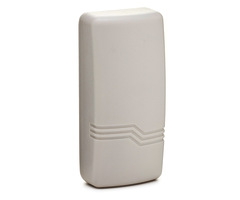How Do I Add a 4-Wire Smoke Detector to My Wireless Alarm System?
To add a 4-wire smoke detector to your wireless alarm, you must use a special type of wireless transmitter. This wireless transmitter must be able to support normally open devices with an end of line resistor (EoLR). This will allow the 4-wire smoke to communicate with the panel wirelessly.
Most wireless alarm systems are intentionally designed to not allow life-safety devices to interface with their hardwired zones. Additionally, most wired to wireless converters only allow burglary hardwired devices to interface with wireless systems. This means that devices such as the Honeywell 5800C2W and the Qolsys Hardwire 16-S will not properly interface with normally open life-safety sensors. Because of this, the easiest solution for owners of wireless systems is to simply use wireless life-safety sensors instead. These wireless devices will readily interface with wireless panels, and they are very easy for end users to install and program.
However, it is not uncommon for the owner of a wireless alarm system to want to use hardwired smoke detectors with their setup. This may be because they have pre-existing hardwired smoke detectors, or they might want to achieve a setup where if one smoke activates, all of the other smokes will activate as well. Whether or not a hardwired smoke can interface with a wireless alarm system depends on the type of hardwired smoke that is being used. A main point to remember is that 2-wire smokes cannot be used with wireless systems. Fortunately, 4-wire smokes can.
But that being said, there is some special equipment needed to interface a 4-wire smoke with a wireless system. The main piece of equipment needed is a wireless transmitter that can support normally open devices that utilize end of line resistors. One such transmitter that offers this functionality is the Honeywell 5817CBXT. The user will also need a power supervision relay module, a reset switch, an appropriate resistor, and an external power supply. The relay module is necessary for properly resetting a 4-wire smoke after an alarm occurs. An important thing for a user to consider is that multiple 4-wire smokes can be used with the same wireless transmitter if they are wired together in parallel. As long as the power supply can handle the load, additional 4-wire smokes can be added. Remember, a stronger power supply can always be added if needed.
Although using a 4-wire smoke with a wireless system might seem complicated, the process can actually be broken down into the following steps:
1. Wire the smoke. The smoke detector will connect directly to the wireless transmitter. Remember, the transmitter must be able to support normally open devices and allow the use of an end of life resistor. A relay module for resetting, as well as for power supervision, the proper resistor and an external power supply will also need to be wired into the setup. For more information on wiring, please consult the manuals for the 4-wire smoke and the transmitter.
2. Program the smoke. The 4-wire smoke will learn-in with the panel as a wireless zone. The zone will be assigned the serial number of the wireless transmitter. The zone must use the appropriate Loop Number for the sensor that allows it to function as a wireless transmitter with resistor. Please consult the manual for the wireless transmitter for more information. From there, the zone can be set up in the same way as any other smoke detector.
3. Test the smoke. With the smoke learned-in, it should then be tested to ensure that it is functioning properly. If your system is monitored by a central station, make sure that your system is placed on test mode before testing. Fire alarms are a very serious situation, and you do not want to cause any false alarms. The smoke detector may have a test button, or you can use canned smoke to conduct the test. Verify that everything is functioning properly.
4. Install the smoke. Once you are sure that the smoke is functioning properly, you can mount the device in its final location. From there, you must maintain the smoke by testing it every few months and by changing the batteries in the transmitter when indicated.
Did you find this answer useful?
We offer alarm monitoring as low as $10 / month
Click Here to Learn MoreRelated Products




Related Categories
- Answered

